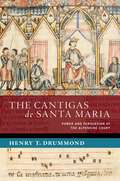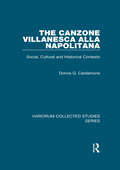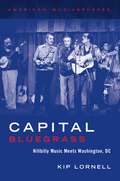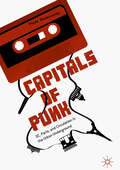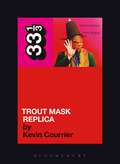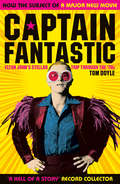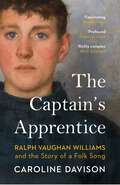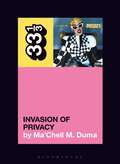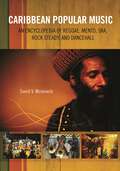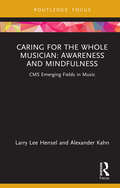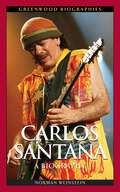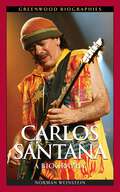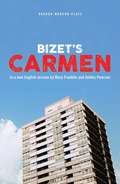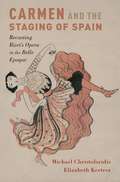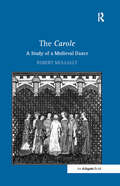- Table View
- List View
The Cantigas de Santa Maria: Power and Persuasion at the Alfonsine Court (NEW CULTURAL HISTORY OF MUSIC SERIES)
by Henry T. DrummondAlfonso X (1221-84) ruled over the Crown of Castile from 1252 until his death. Known as "the Wise," he oversaw the production of a wealth of literature in his scriptorium. One of the most impressive of these literary outputs is the collection of songs known as the Cantigas de Santa Maria, which by most counts comprises 429 songs preserved in four manuscripts. The miracle songs (or cantigas de miragre) form the focus of this book. While the Cantigas have been the subject of much scholarly attention, only a handful of studies have looked at the repertory through an interdisciplinary lens. Fewer still have probed how the Cantigas use the power of song as a communicative medium, one that functions as a social tool within the erudite environment of the Alfonsine court. This book offers a new perspective to the song collection, probing how the Cantigas use their music and text, together with rhetorical devices, to communicate with their desired audience. Author Henry T. Drummond builds upon previous methodologies, adopting a novel and holistic assessment of the songs' melodies, poetic features, and narrative logic to assess a wide selection of songs. He presents a nuanced understanding of a song form that effectively conveys its narratives to its listeners via a diverse combination of tools, embracing medieval rhetoric, rhyme-based play, and song's inherent ludic potential. Such devices, Drummond argues, allow for the Cantigas to loom large as propaganda pieces, designed to dignify Alfonso X through an elaborately devised courtly ritual.
The canzone villanesca alla napolitana: Social, Cultural and Historical Contexts
by Donna G. CardamoneThe printed debut of the canzone villanesca alla napolitana occurred on 24 October 1537, in Naples. Fifteen anonymous 'rustic songs' were published by Johannes de Colonia in a pocket-sized anthology with a cover featuring three women with hoes tilling the soil. The adjective villanesca (from villano or peasant) in the strict sense of the word means rustic or crude, but in this new context it also intimates that Neapolitan poet-musicians had been affected by the instinctive lyrical traditions of everyday people. The articles in this volume trace the Neapolitan origins of this song form, and its subsequent development as it spread quickly throughout Italy in a succession of editions published in Venice and Rome, providing a diverse repertory of lively songs to amuse the privileged that held and attended academies. Several studies focus on key figures in this process, notably Ferrante Sanseverino, Prince of Salerno, and Orlando di Lasso. At the same time the author relates these developments to the contemporary political context, notably the rivalry of Spain and France for control of the Kingdom of Naples.
The canzone villanesca alla napolitana: Social, Cultural and Historical Contexts
by Donna G. CardamoneThe printed debut of the canzone villanesca alla napolitana occurred on 24 October 1537, in Naples. Fifteen anonymous 'rustic songs' were published by Johannes de Colonia in a pocket-sized anthology with a cover featuring three women with hoes tilling the soil. The adjective villanesca (from villano or peasant) in the strict sense of the word means rustic or crude, but in this new context it also intimates that Neapolitan poet-musicians had been affected by the instinctive lyrical traditions of everyday people. The articles in this volume trace the Neapolitan origins of this song form, and its subsequent development as it spread quickly throughout Italy in a succession of editions published in Venice and Rome, providing a diverse repertory of lively songs to amuse the privileged that held and attended academies. Several studies focus on key figures in this process, notably Ferrante Sanseverino, Prince of Salerno, and Orlando di Lasso. At the same time the author relates these developments to the contemporary political context, notably the rivalry of Spain and France for control of the Kingdom of Naples.
Capital Bluegrass: Hillbilly Music Meets Washington, DC (American Musicspheres)
by Kip LornellWith its rich but underappreciated musical heritage, Washington, D.C. is often overlooked as a cradle for punk, the birthplace of go go, and as the urban center for bluegrass in the Untied States. Capital Bluegrass: Hillbilly Music Meets Washington, D.C. richly documents the history and development of bluegrass in and around the nation's capital since it emerged in the 1950s. In his seventeenth book, American vernacular music scholar Kip Lornell discusses both well-known progressive bluegrass bands including the Country Gentlemen and the Seldom Scene, and lesser known groups like the Happy Melody Boys, Benny and Vallie Cain and the Country Clan, and Foggy Bottom. Lornell focuses on colorful figures such as the brilliant and eccentric mandolin player, Buzz Busby, and Connie B. Gay, who helped found the Country Music Association in Nashville. Moving beyond the musicians to the institutions that were central to the development of the genre, Lornell brings the reader into the nationally recognized Birchmere Music Hall, and tunes in to NPR powerhouse WAMU-FM, which for five decades broadcast as much as 40 hours a week of bluegrass programming. Dozens of images illuminate the story of bluegrass in the D.C. area, photographs and flyers that will be new to even the most veteran bluegrass enthusiast. Bringing to life a music and musical community integral to the history of the city itself, Capital Bluegrass tells an essential tale of bluegrass in the United States.
Capital Bluegrass: Hillbilly Music Meets Washington, DC (American Musicspheres)
by Kip LornellWith its rich but underappreciated musical heritage, Washington, D.C. is often overlooked as a cradle for punk, the birthplace of go go, and as the urban center for bluegrass in the Untied States. Capital Bluegrass: Hillbilly Music Meets Washington, D.C. richly documents the history and development of bluegrass in and around the nation's capital since it emerged in the 1950s. In his seventeenth book, American vernacular music scholar Kip Lornell discusses both well-known progressive bluegrass bands including the Country Gentlemen and the Seldom Scene, and lesser known groups like the Happy Melody Boys, Benny and Vallie Cain and the Country Clan, and Foggy Bottom. Lornell focuses on colorful figures such as the brilliant and eccentric mandolin player, Buzz Busby, and Connie B. Gay, who helped found the Country Music Association in Nashville. Moving beyond the musicians to the institutions that were central to the development of the genre, Lornell brings the reader into the nationally recognized Birchmere Music Hall, and tunes in to NPR powerhouse WAMU-FM, which for five decades broadcast as much as 40 hours a week of bluegrass programming. Dozens of images illuminate the story of bluegrass in the D.C. area, photographs and flyers that will be new to even the most veteran bluegrass enthusiast. Bringing to life a music and musical community integral to the history of the city itself, Capital Bluegrass tells an essential tale of bluegrass in the United States.
Capitals of Punk: DC, Paris, and Circulation in the Urban Underground
by Tyler SonnichsenCapitals of Punk tells the story of Franco-American circulation of punk music, politics, and culture, focusing on the legendary Washington, DC hardcore punk scene and its less-heralded counterpart in Paris. This book tells the story of how the underground music scenes of two major world cities have influenced one another over the past fifty years. This book compiles exclusive accounts across multiple eras from a long list of iconic punk musicians, promoters, writers, and fans on both sides of the Atlantic. Through understanding how and why punk culture circulated, it tells a greater story of (sub)urban blight, the nature of counterculture, and the street-level dynamics of that centuries-old relationship between France and the United States.
Captain Beefheart's Trout Mask Replica (33 1/3)
by Kevin CourrierIn the spring of 1969, the inauspicious release of Captain Beefheart and the Magic Band's Trout Mask Replica, a double-album featuring 28 stream-of-consciousness songs filled with abstract rhythms and guttural bellows, dramatically altered the pop landscape.Yet even if the album did cast its radical vision over the future of music, much of the record's artistic strength is actually drawn from the past. This book examines how Beefheart's incomparable opus, an album that divided (rather than) united a pop audience, is informed by a variety of diverse sources. Trout Mask Replica is a hybrid of poetic declarations inspired by both Walt Whitman and the beat poets, the field hollers of the Delta Blues, the urban blues of Howlin' Wolf, the gospel blues of Blind Willie Johnson, and the free jazz of Ornette Coleman. This book illustrates how Trout Mask Replica was not so much an arcane specimen of the avant-garde, but rather a defiantly original declaration of the American imagination.
Captain Beefheart's Trout Mask Replica (33 1/3)
by Kevin CourrierIn the spring of 1969, the inauspicious release of Captain Beefheart and the Magic Band's Trout Mask Replica, a double-album featuring 28 stream-of-consciousness songs filled with abstract rhythms and guttural bellows, dramatically altered the pop landscape.Yet even if the album did cast its radical vision over the future of music, much of the record's artistic strength is actually drawn from the past. This book examines how Beefheart's incomparable opus, an album that divided (rather than) united a pop audience, is informed by a variety of diverse sources. Trout Mask Replica is a hybrid of poetic declarations inspired by both Walt Whitman and the beat poets, the field hollers of the Delta Blues, the urban blues of Howlin' Wolf, the gospel blues of Blind Willie Johnson, and the free jazz of Ornette Coleman. This book illustrates how Trout Mask Replica was not so much an arcane specimen of the avant-garde, but rather a defiantly original declaration of the American imagination.
Captain Fantastic: Elton John's Stellar Trip Through the '70s - subject of the major new movie 'Rocketman'
by Tom DoyleIn August 1970 Elton John achieved overnight fame after a rousing performance at the Troubadour in Los Angeles; over the next five years he was unstoppable, scoring seven consecutive number 1 albums and sixteen Top 10 singles in America. But behind his outré image and comedy glasses lay a desperately shy individual, conflicted about his success, his sexuality, and his narcotic indulgences. In 1975, at the apex of his fame, John attempted suicide yet, after announcing his retirement in 1977 at the age of thirty as well as coming out as a gay man, he gradually found his way back to music. Captain Fantastic is an intimate look at the rise, fall and rise again of John’s fame-and-drug fuelled decade, with a final section bringing his life up to the present.
The Captain's Apprentice: Ralph Vaughan Williams and the Story of a Folk Song
by Caroline DavisonA beautifully written exploration of the world of Edwardian folk music, and its influence on the composer Ralph Vaughan WilliamsIn January 1905 the young Vaughan Williams, not yet one of England's most famous composers, visited King's Lynn, Norfolk, to find folk songs 'from the mouths of the singers'. He had started collecting in earnest little more than a year before but was now obsessed with saving these indigenous tunes before they were lost forever. An old fisherman, James 'Duggie' Carter, performed 'The Captain's Apprentice', a brutal tale of torture sung to the most beautiful tune the young composer had ever heard.The Captain's Apprentice is the story of how this mysterious song 'opened the door to an entirely new world of melody, harmony and feeling' for Vaughan Williams. With this transformational moment at its heart, the book traces the contrasting lives of the well-to-do composer and a forgotten King's Lynn cabin boy who died at sea, and brings fresh perspectives on Edwardian folk-song collectors, the singers and their songs.While exploring her own connections to folk song, via a Hebridean ancestor, a Scottish ballad learnt as a child and memories of family sing-songs, the author makes the unexpected discovery that Vaughan Williams has been a hidden influence on her musical life from the beginning - an experience she shares with generations of twentieth-century British schoolchildren.Published for Vaughan Williams's 150th birthday in August, this evocative, sensitive look at the great composer will also be read on BBC Radio 4. 'No stone is left unturned in the meticulous gathering. Her gift is a work of love and infinite care' - KEGGIE CAREW'I thoroughly enjoyed this book, and its weaving of biography, social history and folk song.' - STEVE ROUD
Cardi B's Invasion of Privacy (33 1/3)
by Ma’Chell M. DumaThe apex of critical praise and commercial success is a metric achieved by a select few. In 2020, Cardi B became synonymous with “record breaking” as her debut album Invasion of Privacy went five times platinum and became the longest charting record by a female rapper in history. From streaming and charting to views, likes, retweets, and shares, Cardi dominates. Cardi B's ascension to stardom is pure 21st century: from welfare kid to unapologetic stripper; reality TV persona, to social media maven, to a household name delivering one of the consummately executed albums in rap history, it's easy to imagine future critics noting popular music as before and after the rise of Cardi B.This in-depth look at Invasion of Privacy explores the sexual politics of hip hop through a track-by-track breakdown of the album. It addresses questions like: How does the wage gap impact pop music? Has Cardi destigmatized sex work for artists? What would hip hop look like as a matriarchy? Each chapter explores the musicality and social constructs that shape the album and a new movement in femme rap.
Cardi B's Invasion of Privacy (33 1/3)
by Ma’Chell M. DumaThe apex of critical praise and commercial success is a metric achieved by a select few. In 2020, Cardi B became synonymous with “record breaking” as her debut album Invasion of Privacy went five times platinum and became the longest charting record by a female rapper in history. From streaming and charting to views, likes, retweets, and shares, Cardi dominates. Cardi B's ascension to stardom is pure 21st century: from welfare kid to unapologetic stripper; reality TV persona, to social media maven, to a household name delivering one of the consummately executed albums in rap history, it's easy to imagine future critics noting popular music as before and after the rise of Cardi B.This in-depth look at Invasion of Privacy explores the sexual politics of hip hop through a track-by-track breakdown of the album. It addresses questions like: How does the wage gap impact pop music? Has Cardi destigmatized sex work for artists? What would hip hop look like as a matriarchy? Each chapter explores the musicality and social constructs that shape the album and a new movement in femme rap.
Caribbean Popular Music: An Encyclopedia of Reggae, Mento, Ska, Rock Steady, and Dancehall (Non-ser.)
by David V. MoskowitzReggae music is more than just steel drum bands on white sand beaches. Its history is rich with culture and evolution, helping to tell the story of Jamaica's past. Due to its depth and extensive coverage, this book is the most complete and up to date encyclopedia about reggae, mento, ska, rocksteady, and dancehall music on the market today. Ideal for reggae lovers and college students studying music, this encyclopedia is comprehensive for high school students and non-music students as well. From Bob Marley to Wayne Wonder, this easy to use encyclopedia contains over 700 entries. Indices in both the front and back of the book make navigating through entries extremely user-friendly.Entries cover singers and songwriters, producers, record labels, and different styles of music that evolved from reggae. Moskowitz truly captures the history and evolution of Jamaican music in this extensive, illuminating encyclopedia, while all the while making it accessible to both high school and college students.
Caring for the Whole Musician: CMS Emerging Fields in Music (CMS Emerging Fields in Music)
by Larry Lee Hensel Alexander KahnCaring for the Whole Musician brings together insights from two expert musicians and educators to consider the relationship between mental and physical health and artistic practice for musicians. Offering a holistic perspective that encompasses the whole being – body, mind, and heart – this book provides emerging musicians with tools, practices, and mindsets to address key challenges throughout their journey.The first part, Awareness, addresses wellness and embodiment in music, exploring how our bodies are constructed and how the use of our bodies as instruments affects function. Using approaches including Body Mapping and the Alexander Technique, this part helps readers discover adverse habits that interfere with natural movement, and nurture awareness of the body. The second part, Mindfulness, explores how meditative practice can be incorporated into every stage of concert preparation and embedded within the daily life of the musician. Offering mindfulness exercises related to each stage of the music-making process, these chapters provide strategies for readers to enhance their well-being and focus.Centered in the understanding of the musician as a whole being, this book provides an essential guide to how practices of awareness and mindfulness can allow musicians to better care for themselves and flourish in their artistic careers.
Caring for the Whole Musician: CMS Emerging Fields in Music (CMS Emerging Fields in Music)
by Larry Lee Hensel Alexander KahnCaring for the Whole Musician brings together insights from two expert musicians and educators to consider the relationship between mental and physical health and artistic practice for musicians. Offering a holistic perspective that encompasses the whole being – body, mind, and heart – this book provides emerging musicians with tools, practices, and mindsets to address key challenges throughout their journey.The first part, Awareness, addresses wellness and embodiment in music, exploring how our bodies are constructed and how the use of our bodies as instruments affects function. Using approaches including Body Mapping and the Alexander Technique, this part helps readers discover adverse habits that interfere with natural movement, and nurture awareness of the body. The second part, Mindfulness, explores how meditative practice can be incorporated into every stage of concert preparation and embedded within the daily life of the musician. Offering mindfulness exercises related to each stage of the music-making process, these chapters provide strategies for readers to enhance their well-being and focus.Centered in the understanding of the musician as a whole being, this book provides an essential guide to how practices of awareness and mindfulness can allow musicians to better care for themselves and flourish in their artistic careers.
Carlos Chavez: A Guide to Research
by Robert L. ParkerFirst Published in 1998.The purpose of this volume is to list as completely as possible Chávez’s compositions, which number close to two hundred works, and to present a digest of selected literature germane to his multi-faceted professional activity. This literature, which began in the 1920s and continues to grow, is almost entirely in Spanish and English, reflecting the main arenas in which he worked—Mexico, other Hispanic language countries, the United States, and England. Each research guide offers a selective, annotated list of writings, in all European languages, about one or more composers. There are also lists of works by the composer, unless these are available elsewhere. Biographical sketches and guides to library resources, organizations, and specialists are presented. As appropriate to the individual composer, there are maps, photographs, or other illustrative matter, glossaries, and indexes.
Carlos Chavez: A Guide to Research
by Robert L. ParkerFirst Published in 1998.The purpose of this volume is to list as completely as possible Chávez’s compositions, which number close to two hundred works, and to present a digest of selected literature germane to his multi-faceted professional activity. This literature, which began in the 1920s and continues to grow, is almost entirely in Spanish and English, reflecting the main arenas in which he worked—Mexico, other Hispanic language countries, the United States, and England. Each research guide offers a selective, annotated list of writings, in all European languages, about one or more composers. There are also lists of works by the composer, unless these are available elsewhere. Biographical sketches and guides to library resources, organizations, and specialists are presented. As appropriate to the individual composer, there are maps, photographs, or other illustrative matter, glossaries, and indexes.
Carlos Chávez and His World
by Leonora SaavedraCarlos Chávez (1899–1978) is the central figure in Mexican music of the twentieth century and among the most eminent of all Latin American modernist composers. An enfant terrible in his own country, Chávez was an integral part of the emerging music scene in the United States in the 1920s. His highly individual style—diatonic, dissonant, contrapuntal—addressed both modernity and Mexico's indigenous past. Chávez was also a governmental arts administrator, founder of major Mexican cultural institutions, and conductor and founder of the Orquesta Sinfónica de México. Carlos Chávez and His World brings together an international roster of leading scholars to delve into not only Chávez’s music but also the history, art, and politics surrounding his life and work.Contributors explore Chávez’s vast body of compositions, including his piano music, symphonies, violin concerto, late compositions, and Indianist music. They look at his connections with such artistic greats as Aaron Copland, Miguel Covarrubias, Henry Cowell, Silvestre Revueltas, and Paul Strand. The essays examine New York’s modernist scene, Mexican symphonic music, portraits of Chávez by major Mexican artists of the period, including Diego Rivera and Rufino Tamayo, and Chávez’s impact on El Colegio Nacional. A quantum leap in understanding Carlos Chávez and his milieu, this collection will stimulate further work in Latin American music and culture.The contributors are Ana R. Alonso-Minutti, Amy Bauer, Leon Botstein, David Brodbeck, Helen Delpar, Christina Taylor Gibson, Susana González Aktories, Anna Indych-López, Roberto Kolb-Neuhaus, James Krippner, Rebecca Levi, Ricardo Miranda, Julián Orbón, Howard Pollack, Leonora Saavedra, Antonio Saborit, Stephanie Stallings, and Luisa Vilar Payá.Bard Music Festival 2015:Carlos Chávez and His WorldBard CollegeAugust 7-9 and August 14-16, 2015
Carlos Chávez and His World (PDF)
by Leonora SaavedraCarlos Chávez (1899–1978) is the central figure in Mexican music of the twentieth century and among the most eminent of all Latin American modernist composers. An enfant terrible in his own country, Chávez was an integral part of the emerging music scene in the United States in the 1920s. His highly individual style—diatonic, dissonant, contrapuntal—addressed both modernity and Mexico's indigenous past. Chávez was also a governmental arts administrator, founder of major Mexican cultural institutions, and conductor and founder of the Orquesta Sinfónica de México. Carlos Chávez and His World brings together an international roster of leading scholars to delve into not only Chávez’s music but also the history, art, and politics surrounding his life and work.Contributors explore Chávez’s vast body of compositions, including his piano music, symphonies, violin concerto, late compositions, and Indianist music. They look at his connections with such artistic greats as Aaron Copland, Miguel Covarrubias, Henry Cowell, Silvestre Revueltas, and Paul Strand. The essays examine New York’s modernist scene, Mexican symphonic music, portraits of Chávez by major Mexican artists of the period, including Diego Rivera and Rufino Tamayo, and Chávez’s impact on El Colegio Nacional. A quantum leap in understanding Carlos Chávez and his milieu, this collection will stimulate further work in Latin American music and culture.The contributors are Ana R. Alonso-Minutti, Amy Bauer, Leon Botstein, David Brodbeck, Helen Delpar, Christina Taylor Gibson, Susana González Aktories, Anna Indych-López, Roberto Kolb-Neuhaus, James Krippner, Rebecca Levi, Ricardo Miranda, Julián Orbón, Howard Pollack, Leonora Saavedra, Antonio Saborit, Stephanie Stallings, and Luisa Vilar Payá.Bard Music Festival 2015:Carlos Chávez and His WorldBard CollegeAugust 7-9 and August 14-16, 2015
Carlos Santana: A Biography (Greenwood Biographies)
by Norman WeinsteinAs eclectic and paradoxical as its subject, this is the first and only book about Carlos Santana that reveals the full sweep of his musical odyssey.Carlos Santana: A Biography explores the life and music of this extraordinary guitarist, ranging from his professional beginnings—his first regular gig was at a Tijuana strip club—and early success in San Francisco to the definitive songs and albums of the 1970s, the commercial resurgence with 1999's Supernatural, his induction into the Rock and Roll Hall of Fame, and his current work with producer Bill Laswell.Unlike other biographies, this book offers a comprehensive look at Santana's transitions through a variety of musical styles beyond rock, including blues, salsa, jazz, and world music. It also portrays Santana as very much a child of the eclectic musical culture of the 1960s, as well as showing the profound influence of the New Age movement on Santana's life and music.
Carlos Santana: A Biography (Greenwood Biographies)
by Norman WeinsteinAs eclectic and paradoxical as its subject, this is the first and only book about Carlos Santana that reveals the full sweep of his musical odyssey.Carlos Santana: A Biography explores the life and music of this extraordinary guitarist, ranging from his professional beginnings—his first regular gig was at a Tijuana strip club—and early success in San Francisco to the definitive songs and albums of the 1970s, the commercial resurgence with 1999's Supernatural, his induction into the Rock and Roll Hall of Fame, and his current work with producer Bill Laswell.Unlike other biographies, this book offers a comprehensive look at Santana's transitions through a variety of musical styles beyond rock, including blues, salsa, jazz, and world music. It also portrays Santana as very much a child of the eclectic musical culture of the 1960s, as well as showing the profound influence of the New Age movement on Santana's life and music.
Carmen: As Produced At The Manhattan Opera House Under The Direction Of Oscar Hammerstein (classic Reprint) (Oberon Modern Plays)
by Georges BizetThe Olivier Award nominated producers of La Traviata, La bohème and Tosca present a vivid, compelling and devastatingly powerful take on Georges Bizet’s masterpiece. Carmen works minimum wage jobs on the frontline of Britain’s crumbling service industry. Jose falls madly in love with her after a brief fling. As his passion morphs into something uglier, and far more troubling, Carmen realises she might have made a fatal mistake… Sung in English, and blending stark emotional realism with some of the world’s most beloved music, this highly original new production examines toxic relationships in a society on the brink of collapse.
Carmen and the Staging of Spain: Recasting Bizet's Opera in the Belle Epoque (Currents in Latin American and Iberian Music)
by Michael Christoforidis Elizabeth KerteszCarmen and the Staging of Spain explores the Belle Époque fascination with Spanish entertainment that refashioned Bizet's opera and gave rise to an international "Carmen industry." Authors Michael Christoforidis and Elizabeth Kertesz challenge the notion of Carmen as an unchanging exotic construct, tracing the ways in which performers and productions responded to evolving fashions for Spanish style from its 1875 premiere to 1915. Focusing on selected realizations of the opera in Paris, London and New York, Christoforidis and Kertesz explore the cycles of influence between the opera and its parodies; adaptations in spoken drama, ballet and film; and the panorama of flamenco, Spanish dance, and musical entertainments. Their findings also uncover Carmen's dynamic interaction with issues of Hispanic identity against the backdrop of Spain's changing international fortunes. The Spanish response to this now most-Spanish of operas is illuminated by its early reception in Madrid and Barcelona, adaptations to local theatrical genres, and impact on Spanish composers of the time. A series of Spanish Carmens, from opera singers Elena Sanz and Maria Gay to the infamous music-hall star La Belle Otero, had a crucial influence on the interpretation of the title role. Their stories provide a fresh context for the book's reappraisal of leading Carmens of the era, including Emma Calvé and Geraldine Farrar.
Carmen and the Staging of Spain: Recasting Bizet's Opera in the Belle Epoque (Currents in Latin American and Iberian Music)
by Michael Christoforidis Elizabeth KerteszCarmen and the Staging of Spain explores the Belle Époque fascination with Spanish entertainment that refashioned Bizet's opera and gave rise to an international "Carmen industry." Authors Michael Christoforidis and Elizabeth Kertesz challenge the notion of Carmen as an unchanging exotic construct, tracing the ways in which performers and productions responded to evolving fashions for Spanish style from its 1875 premiere to 1915. Focusing on selected realizations of the opera in Paris, London and New York, Christoforidis and Kertesz explore the cycles of influence between the opera and its parodies; adaptations in spoken drama, ballet and film; and the panorama of flamenco, Spanish dance, and musical entertainments. Their findings also uncover Carmen's dynamic interaction with issues of Hispanic identity against the backdrop of Spain's changing international fortunes. The Spanish response to this now most-Spanish of operas is illuminated by its early reception in Madrid and Barcelona, adaptations to local theatrical genres, and impact on Spanish composers of the time. A series of Spanish Carmens, from opera singers Elena Sanz and Maria Gay to the infamous music-hall star La Belle Otero, had a crucial influence on the interpretation of the title role. Their stories provide a fresh context for the book's reappraisal of leading Carmens of the era, including Emma Calvé and Geraldine Farrar.
The Carole: A Study of a Medieval Dance
by Robert MullallyThe carole was the principal social dance in France and England from c. 1100 to c. 1400 and was frequently mentioned in French and English medieval literature. However, it has been widely misunderstood by contributors in recent citations in dictionaries and reference books, both linguistic and musical. The carole was performed by all classes of society - kings and nobles, shepherds and servant girls. It is described as taking place both indoors and outdoors. Its central position in the life of the people is underlined by references not only in what we might call fictional texts, but also in historical (or quasi-historical) writings, in moral treatises and even in a work on astronomy. Dr Robert Mullally's focus is very much on details relevant to the history, choreography and performance of the dance as revealed in the primary sources. This methodology involves attempting to isolate the term carole from other dance terms not only in French, but also in other languages. Mullally's groundbreaking study establishes all the characteristics of this dance: etymological, choreographical, lyrical, musical and iconographical.
